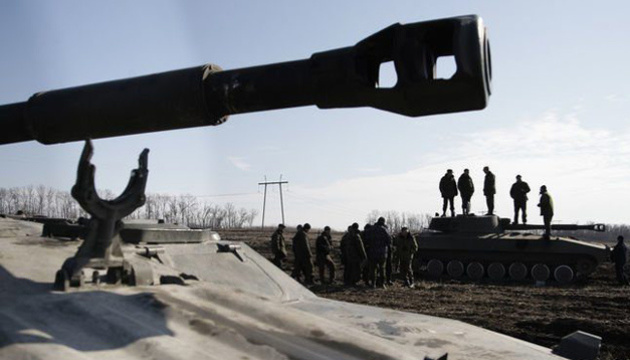
Russia Calibrating Low-Intensity War in Ukraine’s East
Publication: Eurasia Daily Monitor Volume: 18 Issue: 28
By:

From January 21 through February 14, Russian and proxy forces killed 13 Ukrainian soldiers and wounded at least another 19 along the frontline in Ukraine’s Donbas. Most of these casualties were inflicted by snipers, some of whom were apparently deployed from Russia’s interior for a stint of combat training in Donbas (Radio Free Europe, February 3; Ukrinform, February 12, 17).
Sniper fire killed two Ukrainian soldiers on February 11, the day when President Volodymyr Zelenskyy took the G-7 countries’ Kyiv ambassadors on a visit to the frontline (UKrinform, February 11). The enemy command had, apparently, been aware of the scheduled visit and decided to make this demonstrative gesture, albeit not in the visited sector.
The Ukrainian forces do not seem to have retaliated to these attacks. The high command and frontline troops are under orders from the Presidential Office to refrain from responding to provocations, lest the other side escalates and inflicts more casualties. This deliberate restraint is wrapped in official announcements that Ukrainian troops “responded adequately” after each attack when they took casualties.
Russia has chosen to conduct its protracted war in Ukraine’s east in the form of low-intensity positional warfare, punctuated by spikes of relatively higher intensity. Russia calibrates these spikes to keep them below the level of a dramatic escalation; that would not bring Russia any closer to relief from Western economic sanctions and would, moreover, provoke a Ukrainian patriotic backlash. Moscow, therefore, does not go beyond static positional warfare during these phases of intensified operations; it refrains from using heavy weaponry as part of positional warfare; it does not attempt to gain additional territory; and it limits these phases to a few days at a time, during which it inflicts casualties on Ukrainian troops.
These tactics are calculated to exploit President Zelenskyy’s nervousness in the face of casualties and his political investment in showing that the armistice works effectively. The Kremlin aims to pressure Kyiv into concessions on the terms of conflict resolution in the Normandy and Minsk processes. Russia’s intermittent shoot-to-kill phases tend to be correlated with critical phases in the negotiations within the Minsk Contact Group.
The Minsk Contact Group held its fortnightly session by videoconference on February 16–17. Kyiv defended its positions successfully on substance but less so on the procedure. Moscow unleashed the Dontesk and Luhansk delegations to address Kyiv’s delegation directly, so as to create the appearance of direct negotiations between Ukraine and Donetsk-Luhansk.
In the compartment on security affairs, the Donetsk-Luhansk tandem presented demands that Moscow merely “supported,” ostensibly as a “mediator” (TASS, February 16, 17), although Moscow had undoubtedly authored these demands in the first place. The main issue currently at stake is the operation of the Coordinating Mechanism for Ceasefire Observation and Verification, which is supposed to implement the Additional Measures to Strengthen the Ceasefire Regime (Ukrinform, Donetskoye Agentstvo Novostey, Lugansk Infotsentr, February 16, 17).
Both that “mechanism” and those “measures” had been agreed upon by Kyiv and Donetsk-Luhansk within the Contact Group in July 2020. That agreement had lifted the Donetsk-Luhansk forces to the same level as the Ukrainian military in implementing those “measures” through that “mechanism.” The mechanism was to ascertain and report ceasefire violations and to coordinate joint responses to them by the Ukrainian military and the Donetsk-Luhansk forces. The two “sides” would also conduct joint inspections of their respective positions. The “mechanism’s” centerpiece was to be the “Joint Center for Control and Coordination,” a formerly Ukrainian-Russian body in which Russia had yielded its place to Donetsk-Luhansk, so as to compel Kyiv to deal with them directly within that center. The Organization for Security and Cooperation in Europe (OSCE) also had its decorative role to play in those arrangements.
Those arrangements had represented a major success for Moscow and its proxies. They had cast Kyiv and Donetsk-Luhansk as parties to a negotiation and equal participants in the resulting agreement. They practically legitimized the unlawful Donetsk-Luhansk forces. Russia was not mentioned as a party, being exempted of any responsibility for ceasefire violations and, indeed, for the conflict as such. President Zelenskyy and his advisor Andriy Yermak retreated from basic Ukrainian negotiating positions by agreeing to such terms at that time (see EDM, July 29, 30, August 6, 2020).
Yet Kyiv backtracked on those concessions in September 2020, when Moscow’s proxy forces attempted to turn a “joint inspection” with Ukrainian forces in Shumy into a media-political spectacle. That would have deeply embarrassed Kyiv and could have triggered a political backlash there. The “mechanism” and the “joint center” have remained dormant since, although the “additional measures” remain valid (but did not prevent the recent attacks on Ukrainian positions—see above).
The Minsk Contact Group’s February 16–17 session discussed reviving that “mechanism” and the “joint center” at Donetsk-Luhansk’s insistence. They proposed some new modalities for direct, regular exchanges of information, reporting and responding to violations, and joint verification measures. The military-political implications to Kyiv’s detriment and Moscow’s advantage would, however, be the same as in 2020. The Ukrainian delegation currently rejects another such experiment in the Minsk process.
Russia looks set to continue its low-intensity positional war, with periodic spikes designed to inflict Ukrainian casualties and extract political concessions. Moscow’s declared, short-term goals focus on: starting negotiations or direct interactions between Kyiv and Donetsk-Luhansk, introducing the Steinmeier Formula into Ukrainian legislation, and opening the way to “elections” in the Russian-controlled and militarized territory. Kyiv is holding firm at this time and must, therefore, brace for one or more spikes of intensified trench warfare in the spring and summer.



